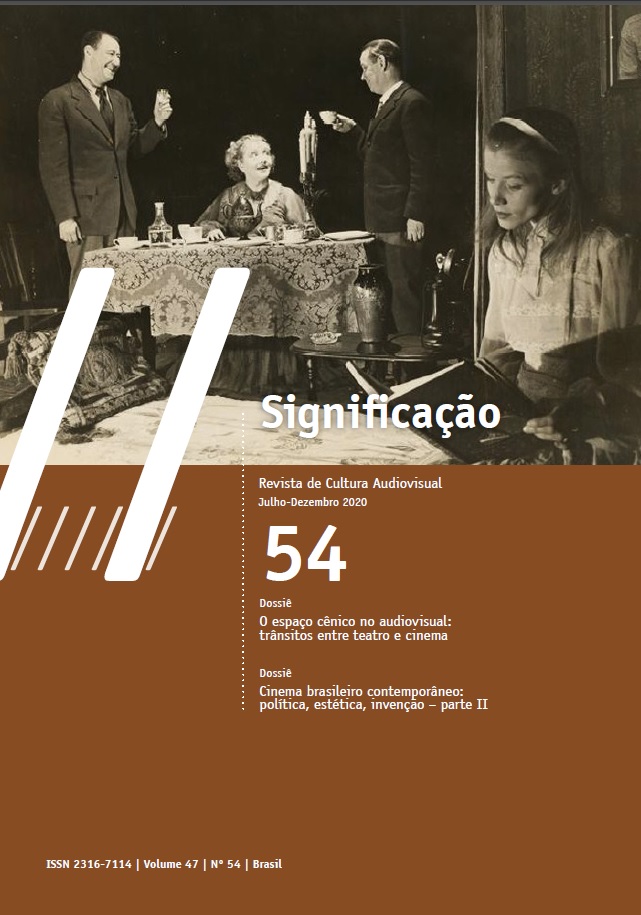The transformation of the war body on screen in Justin Kurzel’s Macbeth
DOI:
https://doi.org/10.11606/issn.2316-7114.sig.2020.157227Keywords:
Corpo bélico, Cinema, Shakespeare, Macbeth, ViolênciaAbstract
This article discusses how the 2015 filmic adaptation of Macbeth by Justin Kurzel is embedded in the social and political context of the 21st century in which the wars of Afghanistan and Iraq reverberate in the physical and psychological state of the soldier. In the film, the war body is scarred by multiple violent experiences of battle and emerges as a damaged individual, one that carries the viscerally traumatic past into the present. I analyze how Macbeth’s military body undergoes a downward spiraling journey from collective leader to lone tyrant that takes roots in his past violent experiences of immersion into a context of corporeal mutilation and death.
Downloads
References
BLOOM, H. Shakespeare: the invention of the human. New York: Riverhead Books, 1998.
BORDWELL, D; THOMPSON, K. Film art: an introduction. New York: McGraw Hill, 2008.
BURNETT, M. T.; WRAY, R. “Introduction”. In: BURNETT, M. T.; WRAY, R. (ed.). Screening Shakespeare in the twenty-first century. Edinburgh: Edinburgh University Press, 2006, p. 1-12.
CALDERWOOD, J. L. Shakespeare and the denial of death. Amherst: University of Massachusetts Press, 1987.
CLARK, S.; MASON, P. “Introduction”. In: CLARK, S.; MASON, P. (ed.). Macbeth. London: Bloomsbury, 2018, p. 1-124. (The Arden Shakespeare).
DAVIES, A. Filming Shakespeare’s plays: the adaptations of Laurence Olivier, Orson Welles, Peter Brooke and Akira Kurosawa. Cambridge: Cambridge University Press, 1990.
GLASMAN, A. “Making Macbeth: behind the scene”. VFX Magazine, Oct. 6, 2015. Available from: http://bit.ly/3eUbWy9. Access on: May 10, 2018.
HAGELIN, S. “Bleeding bodies and post-cold war politics: Saving Private Ryan and the gender of vulnerability”. In: RANDELL, K; REDMOND, S. (org.). The war body on screen. New York: Continuum, 2008, p. 102-119.
JACKSON, R. “Introduction: Shakespeare, films and the marketplace”. In: JACKSON, R. (ed.). The Cambridge companion to Shakespeare on film. Cambridge: Cambridge University Press, 2000, p. 1-12.
JORGENS, J. J. Shakespeare on film. London: Indiana University Press, 1977.
JUNGER, S. “How PTSD became a problem far beyond the battlefield”. Vanity Fair, May 7, 2015. Available from: http://bit.ly/3cAWyoM. Access on: May 17, 2018.
MATTES, A. “Justin Kurzel’s Macbeth: visually magnificent but dramatically unsatisfying”. The Conversation, Sept. 29, 2015. Available from: http://bit.ly/2BDhwGX. Access on: May 15, 2018.
MELBYE, D. Landscape allegory in cinema: from wilderness to wasteland. New York: Palgrave Macmillan, 2010.
PARIS, C. The what and how of PTSD: understanding and moving beyond. Victoria: Friesen Press, 2016.
PARKER, A. “They came back: war and changing national identity”. In: RANDELL, K; REDMOND, S. (org.). The war body on screen. New York: Continuum, 2008, p. 86-101.
RANDELL, K.; REDMOND, S. “Introduction: setting the screen”. In: RANDELL, K; REDMOND, S. (org.). The war body on screen. New York: Continuum, 2008, p. 1-13.
WAGNER, M. “A king(dom) for a stage: the war body in and as performance”. In: RANDELL, K; REDMOND, S. (org.). The war body on screen. New York: Continuum, 2008, p. 50-63.
Audiovisual references
MACBETH. Justin Kurzel, United Kingdom: Studio Canal, 2015.
MACBETH – conference – (en) Cannes 2015. Channel: Festival de Cannes (Officiel). Available from: http://bit.ly/2Y3wIVk. Access on: May 18, 2018.
Downloads
Published
Issue
Section
License
Copyright (c) 2020 Ketlyn Mara Rosa

This work is licensed under a Creative Commons Attribution-NonCommercial 4.0 International License.
Authors who publish in this journal must agree with the following terms:
- Authors keep their copyrights and grant the journal first time publication rights, having their articles simultaneously licensed under the Creative Commons Attribution License, which allows sharing texts with authorship recognition and first publication on this journal for non-commercial purposes.
- Authors are allowed to make additional contracts, for a non-exclusive distribution of the article’s version published on this journal (e.g.: publishing in institutional repositories of articles or as a book chapter), with authorship recognition and first publication on this journal.
















